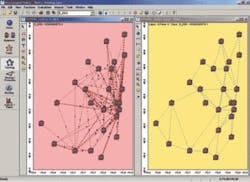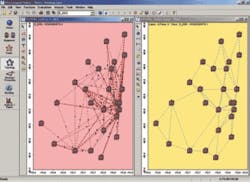Simulation influences network realities
In discussing planning aids, Harsha Vardhana, chief technology officer at VPIsystems (VPI—Holmdel, NJ), believes it important to distinguish between simulation software, which he says is used to model performance before equipment or services are implemented, and the kinds of tools network planners require for infrastructure design and optimization. Vardhana's company offers the Design & Deployment Center, a suite of tools that includes:
- VPItransportMaker: a set of tools that helps optimize SONET/DWDM technologies and networks.
- VPIlinkConfigurator: a vendor-independent tool that performs link engineering,including configuration and performance analysis. A library contains parameters for equipment from different vendors.
- VPIaccessMaker: generates business plans and feasibility studies.
- VPIserviceMaker: a collection of Layer 2 network planning tools to design, dimension, validate, and optimize ATM and voice switched networks as well as Layer 3 tools for modeling and analysis.
The VPIlifecycleManager ties these tools together (other tools are available for vendor applications) to create a collaborative environment that can also include in-house or system vendor tools as well as the carrier's operational support system (OSS), network management system (NMS), and network equipment and configuration databases. Customizable drivers provide interfaces to these outside resources.
The Design & Deployment Center supports both collaboration among carrier design departments and partitioning so that a single group can experiment with network models without creating confusion. Automatic change notification alerts all those involved with the planning process when an approved change to the network model has occurred.
The toolkit can automatically load current network parameters from the OSS or some other database, says Vardhana. In an incumbent-local-exchange-carrier (ILEC) application, Vardhana notes that once VPI and the customer had their definitions aligned, it only took two or three hours to model a network containing 71 add/drop multiplexers. However, he admits that it took two or three days for the ILEC to understand what information was required and make it available.
Meanwhile, RSoft Design Group (Ossining, NY) offers a series of tools to network planners. One is MetroWAND, targeted at the metro environment. As with the VPI product, network planners can automatically load current network configurations (for both ring and mesh architectures) into the tool.
In addition to performing network optimization and enabling the analysis of "what if" scenarios, the tool includes a newly added feature that incorporates a network element's meantime to failure and/or repair to model the reliability of each network element. If a user specifies that routing should be based on maximum availability, the availability values are used to perform what RSoft calls "maximum availability routing." The MetroWAND tool will compute and order paths based on highest availability (i.e., the most reliable path) while maintaining all other service constraints. RSoft expects planners to use this function to support service-level agreements and determine the reliability of various network topologies.
The company also offers physical layer tools, including OpSim and LinkSim. RSoft recently demonstrated version 4.0 of OpSim, which incorporates the capabilities of LinkSim. According to Dr. Brent Whitlock, who manages the product line, the tool enables carriers to design network links while considering nonlinear and other transient behavior of the physical infrastructure. Users can examine such details as the physical parameters of the fiber, transmitters, receivers, multiplexers/demultiplexers, add/drops, filters, and the like to maximize performance, minimize costs, and increase resiliency.
The tool offers eye-diagrams and other output to help determine the effects of noise and investigate bit-error rates and Q factors. "It's very powerful for design because you can perform the investigations and optimizations and analyses in the virtual world much faster and at a much lower cost than going to the laboratory to perform experimental work to determine the same factors," Whitlock says.
The company also offers LambdaSim, which performs wavelength-domain simulation at a level somewhere between MetroWAND's network level and OpSim's physical level. The SWAT tool—originally developed by Telcordia Technologies and now commercialized by RSoft—offers business-case analysis, including expected return on investment for various services and the equipment needed to support them.
While the term "network planning" may conjure an image of engineers plotting infrastructure on a clean sheet of paper, both VPI and RSoft highlight the usefulness of their tools for optimizing current infrastructure. For example, Vardhana says the automatic optimization feature of the Design & Development Center showed the ILEC mentioned in the earlier example a way to remove 20% of its network costs from an existing infrastructure through more efficient traffic routing.
Representatives at both tool companies suggest that users test drive a network planning aid before they buy it. "I would say that a very good way for the operator to move forward is to present a test case and see what the savings are for that test case," Vardhana advises. "And they should present the test case that they know best and they're most confident of, so when they evaluate the solution proposed by the tool vendor, they can benchmark the solution with a higher degree of accuracy."
Tool manufacturers are very open to allowing potential customers to borrow their tools, the two vendors report. Once a purchasing decision is made, pricing generally depends on how many copies of the tool the customer requires.

